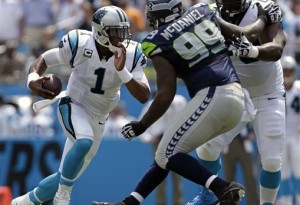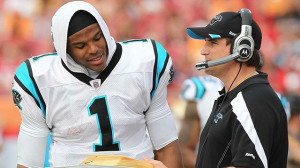But if it seemed like week one was played at turbo speed, you probably didn’t watch the Seahawks-Panthers game. Carolina finished with a league-low 49 offensive plays. For those who didn’t closely monitor the coordinator situation in Carolina, here’s a bit of background. Rob Chudzinski was the Panthers offensive coordinator the past two seasons. His team’s inconsistent play and poor record drew ire from some fans, but the overall impressive nature of the Carolina offense landed him the top job in Cleveland. With head coach Ron Rivera on the hot seat, he simply promoted quarterbacks coach Mike Shula to offensive coordinator. Here’s what my buddy and Footballguys.com co-writer Jason Wood had to say about the change back in June:
Mike Shula last called plays in the NFL in 1999, his final season coaching under Tony Dungy in Tampa Bay. Since then, Shula is better known as the guy who preceded Nick Saban at the University of Alabama and less for his abilities as an NFL offensive difference maker. In spite of his limited recent experience, … it was his relationship with and tutelage of Cam Newton that made him the obvious choice for the OC position.
Schematically, Shula is keeping the foundation of Chudzinski’s offense in place, but in an effort to expedite the pace he has simplified the terminology. By doing so, Cam Newton can get in and out of the huddle far faster and the Panthers can try to dictate tempo in a way that was impossible a season ago. Cam Newton explained in a recent interview, “Twins Right, Key Left, 631 Smash M sounds completely different than Twins Right Tampa…It comes out of your mouth faster. You get in the huddle, it’s the same exact play.”
The early returns on the up-tempo offense are not good — how did the team run just 49 plays against Seattle? Carolina was one of the few teams to have success on the ground in week one — the Panthers rushed for 134 yards on 5.2 yards per carry, placing them in the top six in both metrics. And while Cam Newton didn’t have a great game, he completed 70% of his passes, which usually leads to lots of plays. How does a team that runs well and throws only seven incomplete passes score just 7 points and get limited to 49 plays? As it turns out, Mike Shula bears some of the blame.
Let’s take a look at the traditional boxscore:
The Panthers won the running battle, had a practical push in first downs, and avoided sacks and penalties. Carolina lost the turnover battle, but the glaring item on this boxscore is the discrepancy in passing yards. Let’s dig a little deeper and pull up the drive chart:
In the first half, the Panthers got the ball first but were limited to just four real drives. [1]I’m discounting the fifth drive, which was set up when, with 40 seconds remaining, Charles Johnson strip-sacked Russell Wilson. The Panthers recovered, but elected to just run Mike Tolbert … Continue reading Why? One of the reasons is the team’s glacial pace — the Panthers opening drive lasted over five minutes despite featuring just nine plays and 39 yards worth of action. Carolina routinely took about 40 seconds between snaps on the opening drive.
The second problem: the next two drives were three- and four-and-outs after Carolina failed to convert two third-and-longs.
The fourth drive was an 80-yard march … in every sense of the word … for a touchdown. Carolina slapped together only 11 plays in 6:36 worth of action. On average, all 11-play drives last year took 5:11, and only 10% of all 11-play drives took at least six minutes and thirty-six seconds.
To be fair, the down-tempo drives sandwiched around the unsuccessful drives weren’t the only problems: Carolina’s defense allowed a 15-play, 8:47 drive. And while the Panthers forced three-and-outs on the first two Seattle drives, it was this long drive that resulted in Carolina having only one real possession in the second quarter.
The second half was even worse. The Seahawks had the ball first and last (more on this in a minute), which resulted in Carolina getting just three drives in the second half, and just one fourth quarter drive.
After forcing a Seattle three-and-out to open the second half, punt returner Josh Thomas fumbled, costing the Panthers a possession and valuable field position: even after forcing another three-and-out, Cam Newton and company took over at their own 10-yard line. From there, the Panthers moved like molasses, taking up 4:23 of game time on a six-play drive. How slow is that? The average six-play drive last year took just 2:39, and only 2% of all such drives were as long as the Panthers’ third quarter drive.
Carolina’s sixth drive of the game began at their own 10 with 2:22 left in the third quarter. A holding penalty stunted the drive, and the Panthers punted with 12:30 remaining in the fourth quarter. The Seahawks responded with a short drive for the eventual game-winning touchdown: Seattle scored in under three minutes, as Russell Wilson connected on a deep pass to Jermaine Kearse for the touchdown.
Trailing 12-7, Carolina gained possession at their own 20, and a couple of 15-yard penalties by Michael Bennett and Kam Chancellor had Carolina at the Seattle 43 with 8:23 remaining. Three runs — by DeAngelo Williams, Newton, and then Tolbert — produced another first down, giving Carolina 1st-and-10 at the Seattle 32. Williams then picked up eight yards on first down. But on the next play, Earl Thomas forced a Williams fumble, and Seattle took over at their own eight.
With five Marshawn Lynch runs and four aggressive Russell Wilson passes (credit Pete Carroll for coaching intelligently), the Seahawks were able to pick up four first downs, allowing Wilson to kneel on the ball after the two minute warning.
So how does a team only score 7 points? Losing two fumbles is a start, but the slow pace was another culprit (after all, the Giants scored 31 points despite six turnovers). According to data compiled by Jim Armstrong, the Panthers finished dead last in offensive tempo in week one. Carolina averaged an incredible 35.7 seconds between plays, a full four seconds slower than the next slowest teams (Indianapolis and Cincinnati).Shula’s hire raised some eyebrows, but the early returns indicate an extremely conservative offense. That adjective isn’t just limited to the team’s tempo: In 2012, Newton led the league by averaging 13.8 yards per completion. In week 1, he averaged a mediocre 7.8 yards per completion, a huge tradeoff just to boost his completion percentage. Carolina’s two longest plays went for only 27 and 16 yards, a far cry from the aggressive offense we’ve seen in recent years. The Seahawks have a great defense, so it’s important not to overreact to week one. How the Panthers play this weekend in Buffalo should be revealing.
References
| ↑1 | I’m discounting the fifth drive, which was set up when, with 40 seconds remaining, Charles Johnson strip-sacked Russell Wilson. The Panthers recovered, but elected to just run Mike Tolbert for one play and head into the locker room with a 7-3 lead, so that wasn’t a real drive. |
|---|


